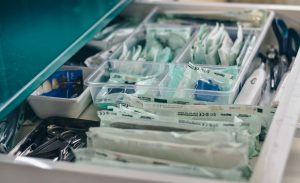The growth in popularity of aesthetic and cosmetic procedures has increased steadily around the world over the past couple of decades, fuelled by the wider availability of pain-free procedures and the unyielding influence of celebrities.
Lip injections and fillers are now a commonplace method of cosmetic treatment, with widespread advertising largely normalising the painful sight of a needle being inserted into lips.
Lip injections usually work by injecting dermal fillers – which can be fat, collagen or a natural substance from the body called hyaluronic acid – into the lips to make them plumper and therefore more youthful looking and potentially attractive to others.
Fat transfer for lip injections are no longer the most popular method but the market value of this process is still estimated to reach over US$4 billion by 2022, while the global dermal fillers market is forecast to surpass $8.5 billion by 2024.

The popularity of lip injections and fillers
While Hollywood star Angelina Jolie is largely credited with the initial popularity of plumper lips when she emerged in 2000, it has also been reported that in 2015, following an episode of Keeping up with the Kardashians where the procedure was discussed in depth, there was a major spike in global Google searches for lip fillers.
These timescales are matched by clinical studies, with one report from the American Society of Plastic Surgeons reporting a 50% increase in lip augmentations for 18 to 55-plus-year-olds between 2000 and 2016.
In 2016, lip injections and fillers was the most popular non-surgical aesthetic treatment in the UK and even regular horror stories of botched procedures show no signs of stopping the continued surge in popularity for the treatment.
Noted 1960s fashion model Twiggy has also reportedly criticized the craze, to no apparent effect on its popularity.
Lip injections and fillers are rising in popularity in Ireland and there have also been reports of teenage girls in Australia “begging” their parents to pay for the procedure ahead of their school balls.
With this seemingly unchecked growth in popularity for lip injections and fillers, clinical experts have become concerned over the comparative lack of regulation for the industry.
In the UK, there has been parliamentary debate over the need to introduce regulation after a spectacularly botched procedure on one patient. There was particular concern over apparently lenient age restrictions on the treatment.
Lip injections and fillers – how do they work?
Dermal fillers used for lip injections work by making lips fuller by replacing the collagen and elastin that naturally reduces over time.
This works by using an active ingredient, hyaluronic acid, which is a natural product of the body and has a unique ability to retain moisture. Human skin is made up of around 70% water so the most effective way of providing a rejuvenating effect is through supplying extra hydration.
Hyaluronic acid works in cosmetic procedures by connecting with natural moisture in the skin and expanding it, which proceeds to fill out lips (and wrinkles, lines and scars) where the increased moisture gives the skin a healthier ‘glowing’ appearance.
The injection is made directly into the lips, where the hyaluronic acid expands the fat inside to give that plumper appearance.
This is seen by many people as a desirable way of not only reversing the effects of ageing, but also the more extreme examples of environmental factors such as pollution and bad weather, which can reduce the production of hyaluronic acid. This subsequently reduces skin elasticity and volume, causing wrinkles and sagging skin.
What is new in lip injection procedures?
As with many aspects of medicine and technology, new innovations and approaches are emerging all the time. The “Lip Smoothie” has been developed by Eudelo London, which takes the hyaluronic acid process and mixes it with platelet-rich plasma, which is extracted from the patient’s own blood.
The use of blood in this way has also been used to stimulate hair growth and reverse balding. As well as creating plumpness in the lips, it stimulates tissue regeneration to ensure the rejuvenated effect is long-lasting.
Another new process recently passed by the FDA in the US is lip threading, which, while not strictly a lip injection, is still a process that involves accessing the inside of lips and filling them out from within.
Another approach is Volbella, which is a lip injection process that smooths out dehydrated lips rather than plumping, and has been praised for being particularly long-lasting – up to a year.
As with many cosmetic procedures, lip injections and the dermal fillers market only look set for a continued rise in popularity in the coming years, thanks to sustained celebrity endorsement and influence, and society’s unyielding fascination with self-appearance and the ‘perfect’ look.
The role of social media in facilitating self-promotion will undoubtedly play a significant role in this ongoing trend.

